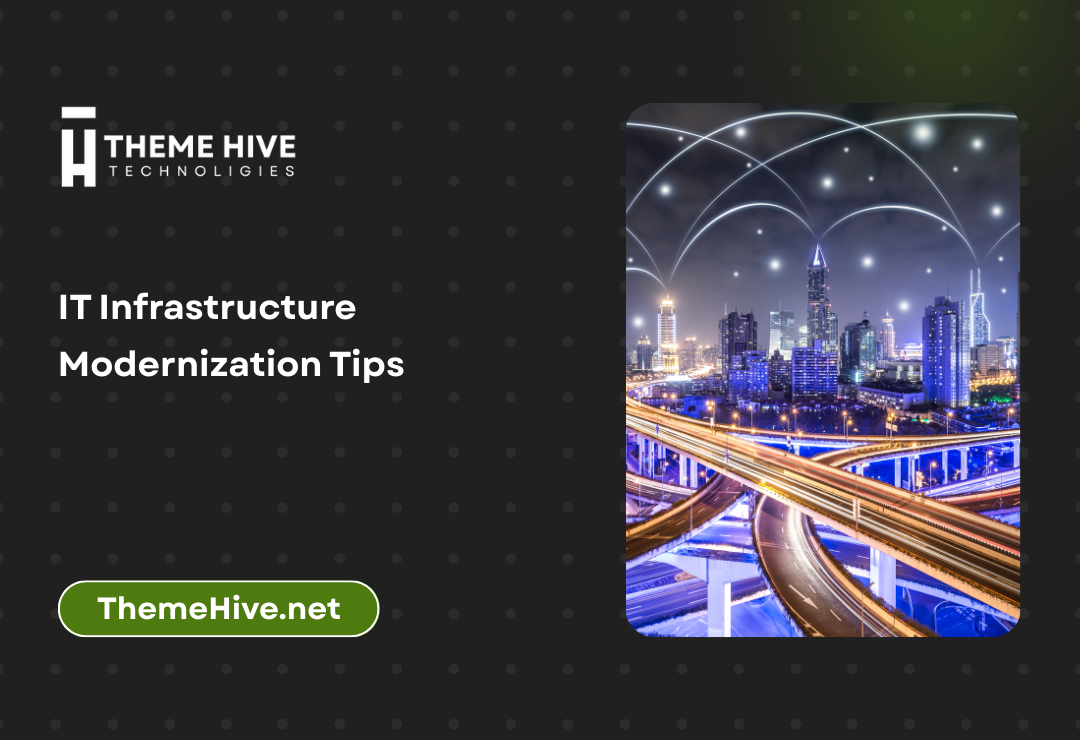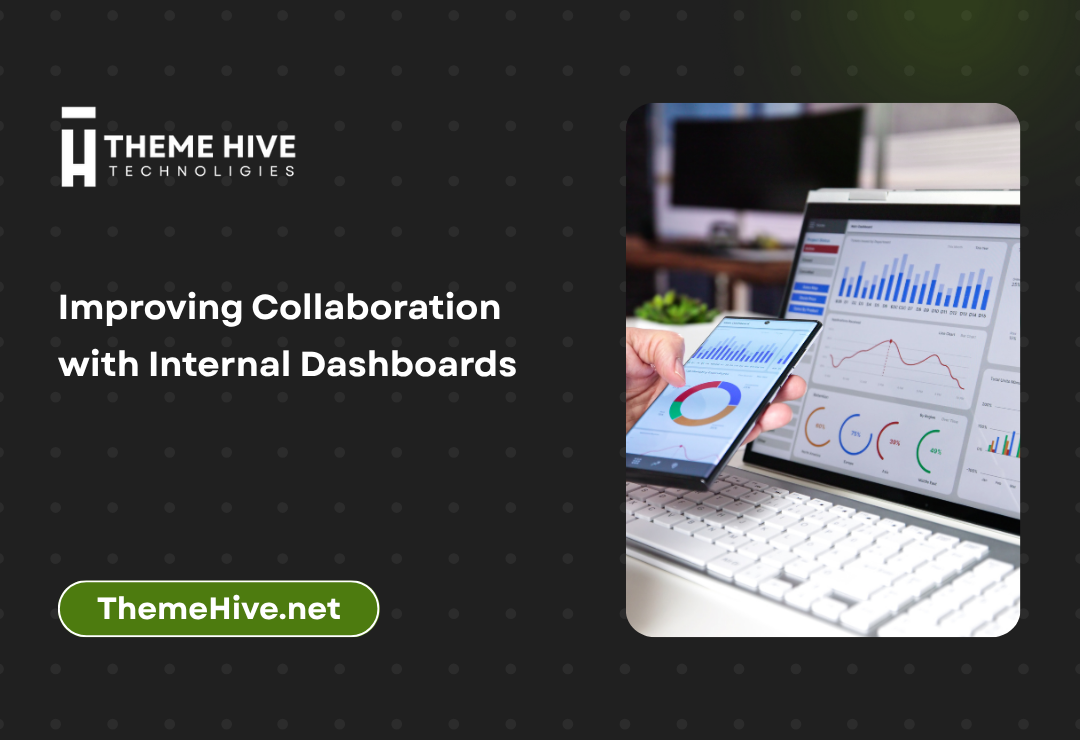As digital transformation accelerates across all industries, IT infrastructure modernization has become a strategic necessity for organizations aiming to remain competitive, agile, and secure. Modernizing your IT environment not only enhances performance and efficiency but also lays the groundwork for innovation, scalability, and future-ready operations.
In this article, we explore practical, actionable tips to successfully modernize your IT infrastructure, ensuring alignment with business goals, cost optimization, and long-term value.
Visit Theme Hive’s Services to discover how we help businesses streamline digital infrastructure.
1. Assess Current Infrastructure Thoroughly
Before jumping into modernization, conduct a comprehensive audit of your existing IT infrastructure:
- Inventory all hardware and software assets
- Identify outdated systems and unsupported technologies
- Analyze utilization rates, bottlenecks, and points of failure
- Assess costs and ROI of current infrastructure
Use this assessment to develop a modernization roadmap with clear priorities.
Tips for IT Infrastructure
Involve key stakeholders across departments to gain a holistic understanding of infrastructure needs and dependencies.
2. Adopt a Cloud-First Approach
Migrating workloads to the cloud is one of the most impactful modernization strategies. Benefits include:
- Elastic scalability
- Cost-effective resource management
- Remote accessibility
- High availability and disaster recovery
Public, private, or hybrid cloud models should be evaluated based on compliance needs, data sensitivity, and operational goals.
Cloud-native architectures also support rapid innovation by enabling microservices, serverless computing, and DevOps practices.
Explore cloud integration insights in our News Articles.
3. Leverage Virtualization and Containerization
Virtualization helps run multiple OS environments on a single physical machine, optimizing hardware usage. Containers like Docker and orchestration tools like Kubernetes provide faster deployment, scalability, and isolation of services.
Benefits:
- Improved resource efficiency
- Easier CI/CD pipeline implementation
- Streamlined DevOps practices
- Scalability across hybrid environments
Virtual machines (VMs) are still valuable for legacy workloads, while containers are best for cloud-native apps.
4. Automate Wherever Possible
Automation minimizes human error, speeds up operations, and improves consistency. Areas to automate:
- System updates and patches
- Provisioning and configuration
- Monitoring and alerts
- Incident response
Recommended Tools:
- Ansible for configuration management
- Terraform for infrastructure provisioning
- Jenkins for CI/CD pipelines
Automation also improves documentation and auditing by generating repeatable workflows.
5. Prioritize Cybersecurity Modernization
Modernizing infrastructure without upgrading cybersecurity measures is a critical risk. Security best practices include:
- Implementing zero-trust architecture
- Multi-factor authentication (MFA)
- Real-time threat detection
- Regular security audits and penetration testing
Emerging Trends:
- Extended Detection & Response (XDR)
- Identity and Access Management (IAM)
- Secure Access Service Edge (SASE)
Stay proactive and secure with support from Theme Hive’s Contact Team.
6. Adopt Software-Defined Networking (SDN)
SDN separates the network control plane from hardware, offering:
- Centralized network management
- Improved scalability
- Faster configuration of networking resources
- Enhanced network visibility and analytics
Software-defined WAN (SD-WAN) further improves connectivity and performance for multi-branch organizations.
7. Embrace Edge Computing for Low Latency
Edge computing processes data closer to the source (e.g., IoT devices), reducing latency and bandwidth use.
Ideal Use Cases:
- Real-time analytics
- Smart manufacturing
- Retail automation
- Autonomous vehicles
- Healthcare diagnostics
Edge computing complements cloud architecture by distributing processing power intelligently and improving resilience.
8. Modernize Legacy Applications
Outdated applications can be costly and difficult to scale. Options include:
- Rehosting (lift and shift)
- Refactoring (modifying code)
- Replatforming (moving to a new runtime)
Evaluation Criteria:
- User demand and business relevance
- Cost of maintenance vs. modernization
- Compatibility with modern cloud services
Modern APIs and containerization often make legacy app transformation smoother.
9. Implement Centralized Monitoring and Analytics
Use tools like Prometheus, Grafana, Splunk, or Datadog to gain visibility into:
- Infrastructure health
- Resource consumption
- Application performance
- Security metrics
Proactive monitoring ensures quick fault detection, capacity planning, and optimized service delivery.
Consider adopting AIOps (Artificial Intelligence for IT Operations) to automate anomaly detection and event correlation.
10. Train and Upskill Your IT Team
Technology evolves rapidly, and your team needs to keep pace. Provide access to:
- Cloud certifications (AWS, Azure, GCP)
- DevOps and automation courses
- Security best practices training
Organizational Benefits:
- Higher employee retention
- Greater operational efficiency
- Reduced risk of misconfigurations
Investing in your team supports long-term digital transformation.
11. Establish a Modern Data Management Strategy
Modern infrastructure depends on efficient data handling. Ensure your organization has strategies for:
- Data governance and compliance
- Data warehousing and lakes
- Real-time data processing
- Scalable storage solutions
Leverage platforms like Snowflake, Apache Kafka, or Google BigQuery to manage and derive insights from data.
12. Build a Phased Modernization Plan
Trying to overhaul everything at once can backfire. Use an iterative strategy:
- Identify quick wins and critical pain points
- Pilot small projects before full-scale adoption
- Align IT initiatives with business objectives
A phased approach reduces risk and helps secure buy-in from stakeholders.
Conclusion
Modernizing IT infrastructure is not a one-size-fits-all approach—it requires careful planning, phased implementation, and ongoing optimization. By adopting cloud technologies, automation, security upgrades, and modern frameworks, organizations can unlock agility, scalability, and resilience.
Explore Theme Hive’s About Page to understand our mission in driving future-ready digital solutions.
Ready to begin your IT infrastructure transformation? Start with a consultation via our Contact Page.
IT Infrastructure







